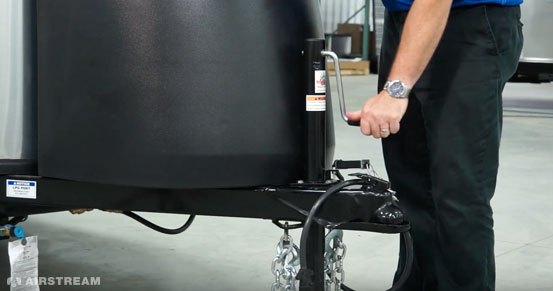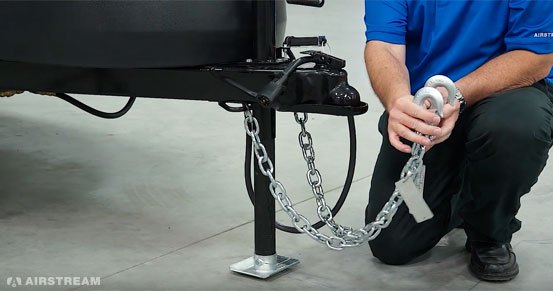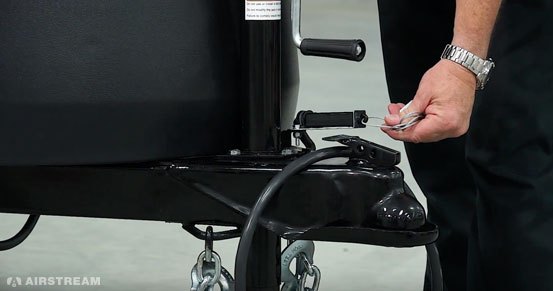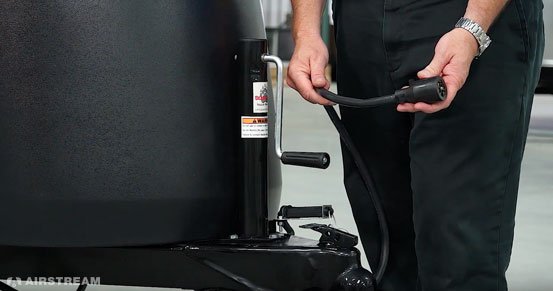Basecamp is our smallest, most ready-for-anything travel trailer. It’s everything you love about an Airstream – quality that lasts + iconic modern design – all in a 16- to 20-foot single-axle floor plan. Unlike larger trailers, you can tow Basecamp with the average SUV, which means you don’t have to upgrade your tow vehicle in order to head out on the adventure of a lifetime.
Whether you’ve got your Basecamp and you’re ready to tow, or you’re still shopping and comparing options, this tour of the towing connections is here to help you understand what comes standard and how you’ll use it.
The Hitch Jack

The black V-shaped steel structure at the front end of the Basecamp is the hitch, which houses all of your towing connections, as well as your battery compartment. The main part of the hitch is the hitch jack – the metal crank lever at waist level. Turning this crank clockwise and counterclockwise raises and lowers the Basecamp on its axle.
Before you connect your Basecamp to your tow vehicle, you’ll first need to raise your Basecamp to clear the ball mount on your tow vehicle. Once your hitch is directly lined up over the ball mount, you’ll lower the hitch jack so that the two connect. You can then raise the jack back up so that your tow vehicle and Basecamp are level.
The Safety Chains

Included with every new Basecamp is a set of heavy-duty safety chains with clips at the ends. After you’ve connected your tow vehicle to your Basecamp at the hitch ball, your next step is to crisscross the chains (so they form an “X”) and secure the clips to the frame of your tow vehicle. Usually there are metal loops on either side of your hitch. Never attach the chains to the outer body of your vehicle, its bumper, or any other plastic element.
Why crisscross the chains? In the unlikely event that your Basecamp becomes detached from your tow vehicle at the hitch while towing, the safety chains will remain connected and can serve as an emergency cradle, keeping your Basecamp from making contact with the ground.
When you’re finished connecting, your chains should have enough slack for turns but not be touching the ground.
The Emergency Breakaway Switch

Installed near the hitch jack is the emergency breakaway switch. Part of the switch is a metal pin. In the unlikely event that your Basecamp becomes disconnected from your tow vehicle while towing, that pin will pull and trigger the breakaway switch to lock the Basecamp’s brakes. Always check to make sure the pin is in place before towing.
It is not recommended to use the breakaway switch as a parking brake, as continued use can damage the switch. To secure your Basecamp when parked on uneven ground, try these tips:
- Park the Basecamp so the tires are perpendicular to any slope in the ground.
- Use wheel chocks to secure the tires in place.
- Use the hitch jack to adjust the level of the trailer according to the slope of the ground.
The Seven-Way Power Cable

Extending from the hitch of the Basecamp is a seven-way (also known as seven-pin) electric power cable, designed to connect directly to your tow vehicle. The power port for this is usually near the license plate and hitch, with a plastic cover to protect it from the elements.
Plug the cable into your tow vehicle to provide power to the brake lights, turn signals, running lights, and emergency flashers. The cable also pulls electricity from your tow vehicle’s engine to charge your Basecamp’s batteries while you’re driving. That way, you have battery power when you arrive and set up camp.
Once you’re hooked up at all of the above connection points, do a quick double check before hitting the road. It’s also a good idea to practice towing in a safe space before heading out on major highways. Check out our towing guide for more tips and information on tow ratings and towing capacity.
Prefer a Video Walkthrough?
Watch an Airstream expert walk through the hitch and towing connections on the Airstream Basecamp.
Want More Basecamp?
Take a closer look at all of the features that make Basecamp perfect for those who love life off the beaten path.










